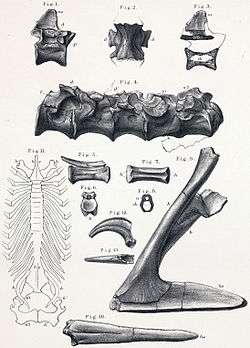Aristosuchus
| Aristosuchus Temporal range: Early Cretaceous | |
|---|---|
 | |
| Assigned elements as figured by Owen | |
| Scientific classification | |
| Kingdom: | Animalia |
| Phylum: | Chordata |
| Class: | Sauropsida |
| Superorder: | Dinosauria |
| Order: | Saurischia |
| Suborder: | Theropoda |
| Infraorder: | Coelurosauria |
| Family: | Compsognathidae |
| Genus: | Aristosuchus |
| Binomial name | |
| Aristosuchus pusillus Owen, 1876 | |
Aristosuchus was a small coelurosaurian dinosaur, whose name was derived from the Greek ἄριστος (bravest, best, noblest) and σουχος, the Ancient Greek corruption of the name of the Egyptian crocodile-headed god Sobek. It shared many characteristics with birds.
Description

Aristosuchus was a bipedal, meat-eating (carnivorous) theropod dinosaur. This predator is thought to have been about 2 meters in length (about 6.5 feet) and is estimated to have weighed about 30 kg (about 65 lbs). According to Gregory S. Paul, its weight was 7 kg.[1]
The femur of Aristosuchus has a wing-like anterior trochanter and a markedly reduced fourth trochanter.
Classification
It was similar to its close relative Compsognathus in appearance and size and some authors have argued that it belongs to that genus. It has also been confused with Calamospondylus, including when Richard Lydekker assumed that Reverend William D. Fox had named it Calamospondylus oweni in 1866. However, on the basis of the pubis, it is considered by Darren Naish to be a valid compsognathid. Since some species are only represented by a few skeletal fragments, this sort of discussion is not uncommon in dinosaur palaeontology. Aristosuchus is known from holotype BMNH R178: a sacrum, a pubis, a femur and a few vertebrae. Two ungual phalanges were found nearby, which may have been from the same animal and would suggest long claws.
Discovery

The type species, Aristosuchus pusillus, was described in 1876, by Richard Owen and named Poekilopleuron pusillus.[2] The specific epithet means "small" in Latin. Harry Govier Seeley (1839–1909) gave it the name Aristosuchus, in 1887.[3]
It was found in deposits from the Early Cretaceous of England, on the Isle of Wight, i.e. from about 125 million years ago.
Notes
- ↑ Paul, G.S., 2010, The Princeton Field Guide to Dinosaurs, Princeton University Press p. 122
- ↑ Owen, R. (1876). "Supplement (No. VII) to the Monograph on the Fossil Reptilia of the Wealden and Purbeck Formations. (Poikilopleuron and Chondrosteosaurus)". Palaeontographical Society Monograph. 30: 1–7.
- ↑ Seeley, H. G. (1887). "On Aristosuchus pusillus (Owen), being further notes on the fossils described by Sir R. Owen as Poikilopleuron pusillus, Owen". Quarterly Journal of the Geological Society of London. 43: 221–228. doi:10.1144/GSL.JGS.1887.043.01-04.22.
Sources
- Naish, D. (2011). "Theropod dinosaurs". In Batten, D. J. English Wealden Fossils. London: The Palaeontological Association. pp. 526–559.
- Naish, D. (2001). "The historical taxonomy of the Lower Cretaceous theropods (Dinosauria) Calamospondylus and Aristosuchus from the Isle of Wight". Proceedings of the Geologist’s Association. London: Elsevier. 113: 153–163.